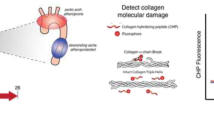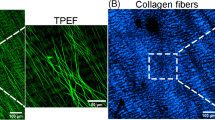Abstract
The assessment of collagen content in tissues is important in biomedical research, since this protein is altered in numerous diseases. Hydroxyproline and Sirius red based assays are the most common methods for collagen quantification. However, these procedures have some pitfalls, such as the requirement of oxygen-free medium or expensive equipment and large sample size or being unsuitable for hydrolyzed collagen, respectively. Our objective was to develop a specific, versatile, and user-friendly quantitative method applicable to small tissue samples and extracts obtained from elastin purification, therefore, suitable for simultaneous quantification of elastin. This method is based on the binding of Sirius red to collagen present in a sample immobilized on a PVDF membrane, as in the dot-blot technique, and quantified by a scanner and image analysis software. Sample loading, Sirius red concentration, temperature and incubation time, type of standard substance, albumin interference, and quantification time are optimized. The method enabled the quantification of (1) intact collagen in several rat tissue homogenates, including small resistance-sized arteries, (2) partially hydrolyzed collagen obtained from NaOH extracts, compatible with elastin purification, and (3) for the detection of differences in collagen content between hypertensive and normotensive rats. We conclude that the developed technique can be widely used since it is versatile (quantifies intact and hydrolyzed collagen), requires small sample volumes, is user-friendly (low-cost, easy to use, minimum toxic materials, and reduced time of test), and is specific (minimal interference with serum albumin).

Dot-blot–Sirius red-based assay for collagen quantification






Similar content being viewed by others
References
Gelse K, Poschl E, Aigner T (2003) Collagens-structure, function, and biosynthesis. Adv Drug Deliv Rev 55(12):1531–1546
Sell DR, Monnier VM Molecular basis of arterial stiffening: role of glycation—a mini-review. Gerontology 58(3):227–237
Greenwald SE (2007) Ageing of the conduit arteries. J Pathol 211(2):157–172
Kragstrup TW, Kjaer M, Mackey AL (2011) Structural, biochemical, cellular, and functional changes in skeletal muscle extracellular matrix with aging. Scand J Med Sci Sports 21(6):749–757
Rolewska P, Al-Robaiy S, Navarrete Santos A, Simm A, Silber RE, Bartling B (2013) Age-related expression, enzymatic solubility and modification with advanced glycation end-products of fibrillar collagens in mouse lung. Exp Gerontol 48(1):29–37
Rizzoni D, Paiardi S, Rodella L, Porteri E, De Ciuceis C, Rezzani R, Boari GE, Zani F, Miclini M, Tiberio GA, Giulini SM, Rosei CA, Bianchi R, Rosei EA (2006) Changes in extracellular matrix in subcutaneous small resistance arteries of patients with primary aldosteronism. J Clin Endocrinol Metab 91(7):2638–2642
Agabiti-Rosei E, Heagerty AM, Rizzoni D (2009) Effects of antihypertensive treatment on small artery remodelling. J Hypertens 27(6):1107–1114
Briones AM, Arribas SM, Salaices M (2010) Role of extracellular matrix in vascular remodeling of hypertension. Curr Opin Nephrol Hypertens 19(2):187–194
Nemethy G, Scheraga HA (1986) Stabilization of collagen fibrils by hydroxyproline. Biochemistry 25(11):3184–3188
Colgrave ML, Allingham PG, Jones A (2008) Hydroxyproline quantification for the estimation of collagen in tissue using multiple reaction monitoring mass spectrometry. J Chromatogr A 1212(1–2):150–153
Reddy GK, Enwemeka CS (1996) A simplified method for the analysis of hydroxyproline in biological tissues. Clin Biochem 29(3):225–229
Colgrave ML, Allingham PG, Tyrrell K, Jones A (2012) Multiple reaction monitoring for the accurate quantification of amino acids: using hydroxyproline to estimate collagen content. Methods Mol Biol 828:291–303
Bolanos AL, Milla CM, Lira JC, Ramirez R, Checa M, Barrera L, Garcia-Alvarez J, Carbajal V, Becerril C, Gaxiola M, Pardo A, Selman M (2012) Role of sonic hedgehog in idiopathic pulmonary fibrosis. Am J Physiol Lung Cell Mol Physiol 303(11):28
Lin SJ, Lu HK, Lee HW, Chen YC, Li CL, Wang LF (2012) Nitric oxide inhibits androgen receptor-mediated collagen production in human gingival fibroblasts. J Periodontal Res 47(6):701–710
Roth M, Zhong J, Zumkeller C, S'Ng CT, Goulet S, Tamm M (2013) The role of IgE-receptors in IgE-dependent airway smooth muscle cell remodelling. PLoS One 8(2):14
Li J, Wei L, Sun J, Guan G (2013) Effect of ionic products of dicalcium silicate coating on osteoblast differentiation and collagen production via TGF-beta1 pathway. J Biomater Appl 27(5):595–604
Lareu RR, Zeugolis DI, Abu-Rub M, Pandit A, Raghunath M (2010) Essential modification of the Sircol Collagen Assay for the accurate quantification of collagen content in complex protein solutions. Acta Biomater 6(8):3146–3151
Mecham RP (2008) Methods in elastic tissue biology: elastin isolation and purification. Methods 45(1):32–41
Judd RC (2002) SDS-polyacrylamide gel electrophoresis of peptides. In: Walker JM (ed) The protein protocols handbook, 2nd edn. Humana Press. Inc., Totowa, NJ
Osborne-Pellegrin M, Labat C, Mercier N, Challande P, Lacolley P (2010) Changes in aortic stiffness related to elastic fiber network anomalies in the Brown Norway rat during maturation and aging. Am J Physiol Heart Circ Physiol 299(1):H144–H153
Lareu RR, Zeugolis DI, Abu-Rub M, Pandit A, Raghunath M (2010) Essential modification of the Sircol collagen assay for the accurate quantification of collagen content in complex protein solutions. Acta Biomater 6(8):3146–3151
Chen YY, Lin SY, Yeh YY, Hsiao HH, Wu CY, Chen ST, Wang AH (2005) A modified protein precipitation procedure for efficient removal of albumin from serum. Electrophoresis 26(11):2117–2127
Kondo C, Nakano S, Suzuki T, Kanamori T (2007) An easily constructed, inexpensive device for dot blotting. Anal Biochem 370(1):115–117
Sweat F, Puchtler H, Rosenthal SI (1964) Sirius red F3ba as a stain for connective tissue. Arch Pathol 78:69–72
Borges LF, Taboga SR, Gutierrez PS (2005) Simultaneous observation of collagen and elastin in normal and pathological tissues: analysis of Sirius-red-stained sections by fluorescence microscopy. Cell Tissue Res 320(3):551–552
Antharavally BS, Carter B, Bell PA, Krishna Mallia A (2004) A high-affinity reversible protein stain for Western blots. Anal Biochem 329(2):276–280
Heidebrecht F, Heidebrecht A, Schulz I, Behrens SE, Bader A (2009) Improved semiquantitative Western blot technique with increased quantification range. J Immunol Methods 345(1–2):40–48
Somoza B, Abderrahim F, Gonzalez JM, Conde MV, Arribas SM, Starcher B, Regadera J, Fernandez-Alfonso MS, Diaz-Gil JJ, Gonzalez MC (2006) Short-term treatment of spontaneously hypertensive rats with liver growth factor reduces carotid artery fibrosis, improves vascular function, and lowers blood pressure. Cardiovasc Res 69(3):764–771
Acknowledgment
This work was supported by the Ministerio de Educación y Ciencia from Spain (FEM2009-13434 C02-02 and FEM2012-37634-C03-01).
Author information
Authors and Affiliations
Corresponding author
Rights and permissions
About this article
Cite this article
Rodríguez-Rodríguez, P., Arribas, S.M., de Pablo, A.L.L. et al. A simple dot-blot–Sirius red-based assay for collagen quantification. Anal Bioanal Chem 405, 6863–6871 (2013). https://doi.org/10.1007/s00216-013-7101-0
Received:
Revised:
Accepted:
Published:
Issue Date:
DOI: https://doi.org/10.1007/s00216-013-7101-0




